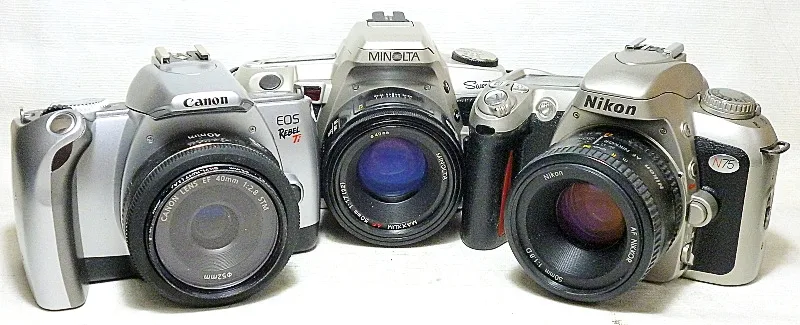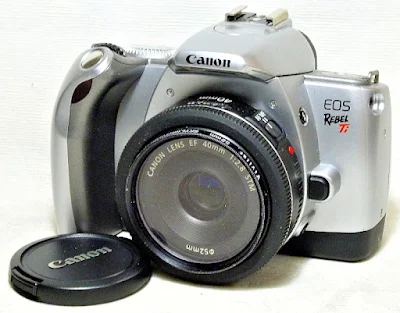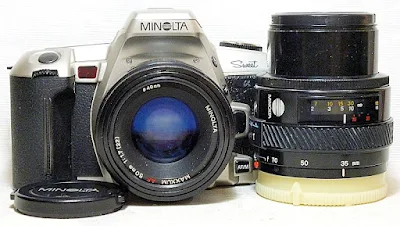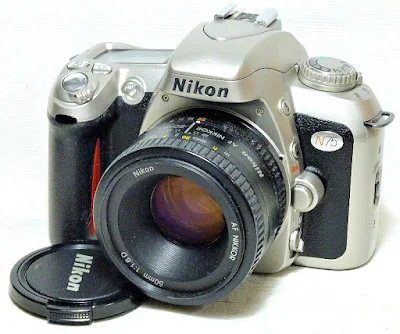Going analog, enjoying the revival, memories, and nostalgia of the printed image, and sharing the crossover with friends and family is as straightforward and simple, and it is also as economical as can be. It will not cost us an arm or a leg, either. This is more so for enthusiasts of vintage digital SLR photography who have their own photography gear, as well as the newbie keen on the art and creativity of the genre.
Cast aside the sweet and longing thoughts for older all-mechanical auto-exposure 35mm film SLR camera models, or further back with earlier fully manual models (and their characteristic lenses which may cost us dearly), because, as the years go by, those cameras are nearing their age of usability and the ability to be repaired, and may just end up as display models on the mantelpiece.
For a very economical and low-cost approach, look instead at late-model 35mm SLR camera bodies produced just before the introduction of the digital SLR camera era. These lightweight plastic-bodied cameras, launched in the late 1990s or early 2000s, are mostly built with advanced mechanical and electronic features, which were later carried over to the brand's digital SLR models.
These late-model camera bodies may include a built-in and retractable camera flash, programmed (PASM) exposure modes, wide-area focus points, honeycomb-matrix or other evaluative autofocus features, fast AF speed, LCD display panels, and, with one or two models, a range of scene modes, or a maximum shutter speed of 1/4000 second.
Inadvertently, you may also find that these cameras are fitted with the same lens mount system as found on the digital SLR system that we already have, meaning that lenses are interchangeable between the two. This is where the added advantage of having both a 35mm SLR film camera and a digital SLR version comes in, and lens or lenses can be interchangeable, which adds to the reduction in cost commitment.
I did the same recently and came away with a selection of late-model 35mm SLR film camera bodies worth looking at. These, as well as many others, are readily available on auction sites or even in brick-and-mortar stores with prices for the asking, with listings that mint or hardly used products, in well-preserved condition, and boxed with their original packing pieces.
Canon EOS Rebel Ti
The Canon EOS Rebel Ti (EOS 300V in Europe, Asia, and Asiana, EOS Kiss 5 in Japan), launched by Canon in 2002, is the penultimate of the best-selling consumer-grade Canon EOS 35mm SLR film camera series. The camera comes with a very ergonomic design finished in incandescent silver and metallic gray, a 7-point area-wide AF, the fastest AF speed in its class, improved predictive AF performance, an EF stainless steel lens mount, and a super slim fit body that weighs only 365 grams.
Metering is open-aperture TTL (through the lens) via a 35-zone SPC (silicon photocell) set to an automatic selection between Evaluative (linkable to any AF point), Partial (set automatically with AE Lock), and Center-weighted Averaging (set automatically in Manual mode). Autofocus, with automatic AF sensor light, is TTL-SIR with a CMOS sensor. The camera is powered by a pair of CR2 Lithium batteries.
Technical specifications include a built-in retractable camera flash; an electronically controlled metal vertical travel focal shutter plane with a shutter speed range from 30 seconds to 1/2000 second, and B, with X-sync at 1/90 second, a 10-second delay electronic self-timer, and depth-of-field preview function. Exposure compensation is the same +2 to -2 EV in 1/2 stop increments. The camera accepts DX-coded 135 film rolls with an ISO speed range from 6-6400.
The camera was later replaced by the final model of the series, the EOX 300X (Eos Rebel T2 / EOS Kiss 70) in 2004.
Minolta Alpha Sweet
The Minolta Alpha Sweet (Maxxum XTsi in the USA, Dynax 505si Super in Europe), introduced by Minolta in 1993, is an A-mount auto-load Japanese domestic model launched as a budget version of the more advanced Minolta Dynax 700si. The camera has an electronically-controlled vertical-travel metal focal-plane shutter with a shutter speed range from 30 seconds to 1/4000 second, and Bulb, with flash sync at 1/125 second or slower, a 10-second timer delay actuation, and single or triple frame shots with auto-bracketing.
Features include a built-in flash, a sophisticated 14-segment honeycomb-metering pattern, a three-point Crosscut AF sensor for accurate autofocusing, eye-start operation, spot metering, and a host of other easy-to-use and advanced functions. The camera accepts films with ISO speeds from 25 to 5000 by DX coding and 6 to 6400 by manual setting in 1/3 EV increments.
Metering is TTL open aperture for light averaging or spot-meter reading, with direct TTL metering for flash. Exposure compensation is +/- 3 stops in 1/2 stop increments. Other full automatic functions include focus hold (autofocus lock), AF lock, 3-frame multiple exposures, eye-start with On/Off setting, and automatic film loading and rewind.
A distinguishing feature of the Alpha Sweet is the customized exposure functions, which provide for PASM shooting modes and enhanced settings for Portrait, Landscape, Close-up, Sports, and Night Portrait. An extended Night Exposure mode can also be set by setting the flash unit off in Night Portrait mode.
The Minolta Alpha Sweet 35mm AF SLR film camera is powered by a pair of CR2 Lithium batteries and is compatible with all Minolta A-mount lenses.
Nikon N75
The Nikon N75 (U2 in Japan, F75 in Europe), launched by Nikon in 2003, was the last consumer-level autofocus 35mm SLR film camera manufactured by Nikon. The camera replaces the N65, which was introduced a couple of years earlier. Belittling its simple look, the U2 is actually a very advanced and capable camera developed to incorporate features and innovations that make the F5, F100, and F80 the top 35mm SLR film cameras of their genre.
The camera has a bodyweight of only 380/385 grams, and comes fitted with an excellent electronically-controlled vertical-travel focal-plane shutter with a speed range from 30 to 1/2000 second, accepts film ISO speeds from 25 to 5000 (set by DX coding only), a veritable selection of automated program and manual shooting modes, remote control sensor, and built-in Speedlight. The camera is powered by a pair of CR2 Lithium batteries.
Metering is by a 25-segment Matrix metering pattern with five user control autofocus sensors via a three-way switch plus a jog dial on the film back. The selection of exposure modes available on the camera includes Auto Multi-Program [P], Shutter-Priority Auto [S], Aperture-Priority Auto [A], and Manual [M], with Point-and-Shoot options including AUTO, Portrait, Landscape, Close-Up, Sports, and Night Portrait shooting.
The AF system of the N75 works with every AF, VR, AF-I, and AF-S lens ever made by Nikon, as well as earlier manual focus lenses, through its in-focus confirmation dot system.
Get A Good Thing Going
Time to get the good going. Film-based photography has experienced a strong revival recently, with photographers of all generations and all photography genres picking up where they left off earlier or starting fresh and anew. Sales for analog photography paraphernalia are also going good, especially on auction-based sites where potential buyers can fix the amount they are willing to spend on each of the listed items they are betting on.























No comments:
Post a Comment